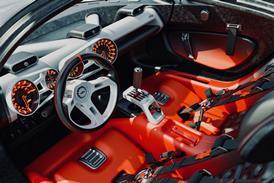Our search for the best young Chinese design talent
On an afternoon recently in Shanghai, around 20 top car design directors from different OEMs and suppliers were gathered – some might say, ‘locked’ – in a hotel ballroom. Posters of concepts and illustrations hung around them in the room or lay on the carpet, their bright colours a study in contrasts and perspectives.
The designers were there for the final, live judging session in this year’s Car Design Awards China, assessing a shortlist of some 30 entries, narrowed down after several rounds and hundreds of applicants from dozens of Chinese universities – the largest trove yet for the awards, now in their 10th year.
Circling the room, the judges argued over forms – some more definably vehicles than others – or the meaning of a luxury storyline. They held up prints in the light or lay down on the floor to trace lines, comparing and debating references. They praised surprising combinations and new mobility ideas.
There was no quick consensus on which were best – indeed, it would almost be disappointing if this many creative minds had agreed so readily – but they eventually chose the winners after several hours of debate and cajoling, which will be announced next week (15th April) at the CDAC awards ceremony in Shanghai.
To some extent, the process was not dissimilar to what can happen in a design studio, where critique, revision and elimination is essential to arriving at the best designs, especially in the high stakes environment of developing new vehicles.
The student competition, too, is not without its own stakes. For students, it is a chance to progress their education and careers. The overall winner receives a funded, 15-week semester studying transportation design at the College of Creative Studies in Detroit. Many past category winners have landed design jobs at OEMs and suppliers.
It also an important process for the judges, who as car design leaders in China compete fiercely for talent – an ever-scarcer resource amid the growth in design studios here. As was the case with this jury, many car design directors in China are expats and lead international teams, but they depend strongly on local talent and insight to develop successful concepts in the world’s most important and fastest-changing market.
While some carmakers in China have had poor reputations when it came to quality and originality, today most in the industry agree that the gap between Chinese domestic, and foreign brands is closing fast, with design increasingly seen as a key part of brand strategy – especially in tech integration, connectivity and luxury aspirations, much of which attracts younger buyers in China.
Design leaders now see a big opportunity for designers who can take the next step both in reaching global quality, as well as developing characteristics unique to Chinese car design.
To those ends, design leaders put a lot of hope in China’s education and university system to develop the country’s changing design culture. In the past decade, the CDN competition has revealed much progress, with shortlisters from more than 100 universities, and a strong set of winners and finalists from a number of elite institutions.
This year, too, many judges noted a high level of professionalism in much of the work, particularly in rendering and presentation, and many interesting ideas on the future of mobility.
We will be running a longer investigation of the status of design education in China following the Shanghai motor show as part of a special design focus on the region.







































